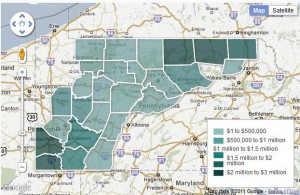Mapping Corbett’s Impact Fee
-
Scott Detrow
UPDATE: The final bill passed by legislators in February 2012 changed the fee’s funding formula. View our new map here.
What would Governor Corbett’s proposed impact fee mean for counties, if it were in place right now? On average, around $682,000.
That’s the amount of money the median drilling county would hold onto, after taking in $2.5 million in fees, sending 25 percent to the state, and then splitting the remaining total between itself and municipalities, using the 36/37/37 formula Corbett has suggested.
Click on the interactive map to the left to see how much money Corbett’s fee would deliver to your county.
The figures are based on the latest well production information released by the Department of Environmental Protection. The July figures track 1,642 active Marcellus Shale wells in Pennsylvania. Applying a $40,000 fee to each of them, we arrive at a statewide haul of $65.7 million – a bit more than half of what the Corbett Administration expects to bring in in Year 1.
Why the difference? The governor’s office expects an additional 1,500 wells to come online by the time a fee is implemented next year. Their $120 million Year 1 estimate is based on 3,000 wells.
We can’t predict what wells will spring up where, so this map provides a snapshot of how much each county would take in, based on:
-current production numbers
-the assumption every drilling county would impose a first-year fee of $40,000
How much money would each county see, under Corbett’s plan? StateImpact’s map explains. The “Local Share” is the amount of money that stays at the county and municipal level. The “County Share” listed below that shows how much revenue each county would keep, after it doles out money to its boroughs and townships.
For more on Corbett’s proposed plan, check out our impact fee primer.

















